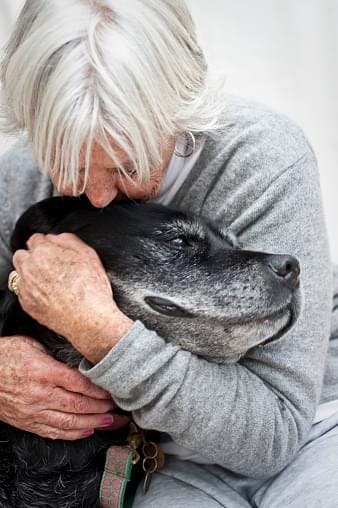While there is no greater joy than first getting a pet, there is also no deeper hurt than the impending loss of your furry friend. Since our pet’s lifespans are shorter than ours, it’s important to be prepared for what to expect when letting them go. Making sure you know how to maximize your pet’s comfort leading up to their last days, observing signs, and deciding which options you have will be extremely helpful during the moment, trust us.
What do I do for my pet’s end-of-life care?
It can be overwhelming to think about the process of your pet’s end-of-life. And in reality, it’s different for every pet. If your pet is suffering from labored breathing, extreme fatigue, loss of energy, appetite, and bladder control, and isn’t interested in things that used to make them perk up, it could be time to say goodbye to your furry friend.
Helping care for your pet at their final moments will greatly impact their well-being, and will maybe even help you start the mourning process. It’s nice to stay close to them so you’re available to give them extra affection and love, and instead of introducing them to new places and people, try to maintain normal activities – it’s all about calmness towards the end.
How will it end?
As your pet starts to go, you have a couple of options in deciding what to do for them. If your pet has a terminal illness, limited mobility, or you have confirmed your pet’s final days are here, you can put them in hospice. Hospice isn’t a physical place – but rather somewhere in your home that will be comfortable for your pet to have their last days. With hospice specifically, the intention is to give them as much affection as they want, make them feel safe, and with a little help from your vet, hospice can also include pain medication if they are experiencing pain. If/when your beloved pet dies at your house, call your vet as soon as possible, so they can discuss proper removal.
Another option is euthanasia, which is a very common route that pet parents take. Instead of waiting for your pet to pass, a vet can end their suffering by injecting them with a sedative, followed by a medication that will bring your pet’s life to a humane end. It’s fast, gentle, and your pet won’t know it’s happening. To know when the best time to euthanize, your vet will either run medical tests, or you may notice that your dog’s quality of life just doesn’t outweigh the need to end their suffering.
Do I cremate them or bury them?
Ultimately, the decision is up to you. After a pet has passed, it’s common for people to cremate them. Having your pet’s ashes in an urn, or something that will help you remember the good times is always helpful. Most pet cremation businesses offer to pick up your furry friend, so you don’t have to deal with transporting. If you plan to bury them, it’s a good idea to check to see if you can do so on your property or not.
What Happens Afterward?
There is no right way to mourn your pet. We could write a dozen articles about grief, but there’s no way to know if they would be of any help. Holding some type of memorial, whatever that looks like to you, is something that many people find comforting. Whether it’s sitting around a bonfire talking about the good days, or having your family and friends join you for your daily walk, it can help to talk about it.
Losing a pet is not something anyone would wish on their worst enemy. However, knowing the signs and what to do when the time comes will make letting them go easier. Not everyone knows the love of a pet, but we’re here to help you get through it.





